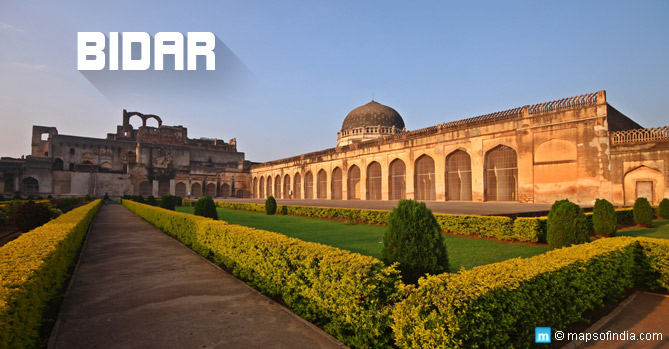Bidar, also referred to as the City of Whispering Monuments, is called the Crown of Karnataka. It is the headquarters of Bidar district located in the north of Karnataka. As a culturally rich city, Bidar is steeped in history and heritage.
Origin of its Name
The name Bidar is derived from the word ‘Bidiru’ meaning bamboo, testimony to the rugged terrain of the Deccan. Bidar shaped much of the medieval history of south central India. Best known for its role in the Bahamani conflict with Vijayanagara Samrajya, Bidar is now a popular getaway.
It is frequented more by the people of Hyderabad and its neighborhood than Karnataka itself. It is increasingly growing popular for its 15th century monuments. Apart from its tourist attractions, Bidar is also a famous pilgrimage centre. It is well known for its Bidri works, i.e. bamboo craft and furniture. The AJT (Advanced Jet Training) or Hawk training centre of the Indian Air Force is also located here.
How to Get to Bidar
By Air – Rajiv Gandhi International Airport of Hyderabad is the nearest airport to Bidar located about 140 kilometres. Buses ply regularly from Hyderabad bus terminus to Bidar. Driving down from Hyderabad, one must take the Hyderabad – Mumbai highway and take a diversion past Zaheerabad.
By Train – Bidar railway station is well connected with most of the major cities of south central India. Mumbai, Bengaluru, Hyderabad, and almost all cities in Karnataka are well connected with Bidar.
By Road – Buses ply from major cities in Karnataka and Andhra Pradesh to Bidar. Taking the train, however, is a more convenient option.
A Historical Outlook
Bidar has been the heart of the Deccan – both geographically and culturally. The earliest history of monarchy in the region, dates back to the times of the Mauryan kings who took control of Bidar. Then, it was the turn of the Satavahanas, Kadambas, Chalukyas, and the Rashtrakutas.
Ala-ud- Din Khilji’s conquest of the Deccan in the late 13th century and early 14th century brought the Sultanate rule to Bidar. By 1347, the Deccan vassals of the Delhi Sultans rebelled giving birth to the Bahamani kingdom in which Bidar played an important role. By 1429, Bidar became the capital city.
The Bahamani kingdom was frequently at war with Vijayanagar and the ascendancy of King Krishnadevaraya only made things worse. Following the Krishnadevaraya’s fall, the Bahamani broke up following internal strife. Bidar, then became the capital of Barid Shahi dynasty and later the Adil Shahi dynasty till Aurangzeb made it part of the Mughal empire.
Having been part of many empires and under the reign of many monarchs, Bidar acquired a cosmopolitan culture, rarely seen in the Deccan states.
Places to Visit
Bidar Fort – The 15th-century Bidar Fort is the highlight of the city. The deep moats, excellent fortifications, and use of red brick remain a sight worthy of being seen. The main entrance constructed by Ahmad Shah Wali in 1429 still stands intact.
Rangin Mahal – The coloured mosaic and the black stone construction inlaid with pearl gives this palace its name. The architecture is a blend of Islamic and ancient Indian schools and the palace was reconstructed during Barid Shahi era.
Chaubara – The Chaubara, an ancient watch tower is a beautiful cylindrical structure located at the heart of Bidar.
Solah Khamba Mosque – The Solah Khamba Mosque is named after the 16 pillars that make up its facade. Built in 1424 by Qubil Sultani, this is still a revered place of worship and is also called the Zanana Masjid.
Gurudwara Nanak Jhira Sahib – Dedicated to the Sikh Guru, Guru Nanak Dev, who is believed to have relieved the region of a severe drought, this is one of the most important Gurdwaras of the region.
Mohamad Gawan Madarsa – Founded in the late 15th century, this was one of the oldest centres for Islamic studies in the country. The large building still remains a prominent landmark in the city.
Narasimha Jhira Cave Temple – This temple dedicated to Lord Narasimha is located in an underground cave and devotees need to wade through water to get to the main shrine.
Papnash Shiva Temple – The Shiva-linga in this famous pilgrimage centre is believed to have been installed by Lord Rama on his way back to Ayodhya after winning over Ravana. A holy dip in the pond is believed to rinse away the devotee’s sins.
Chaukhandi of Hazrat Khalil Ullah – The Chaukhandi of Bidar is a tomb built in memory of Hazrat Khalil Ullah, the mentor and spiritual adviser of Sultan Ahmed Shah.
Bahamani Tombs – Twelve large tombs, popularly called the Bahamani tombs, are located to the east of Bidar town. They are known for their flowing architecture. The most famous among these is the tomb of Ala-ud-Din Hassan Bahman Shah.
Best Time To Visit
Bidar experiences extreme heat during the summer months from March to June. Temperatures shoot up to 40°C in May, making it unsuitable for travel. This is followed by torrid rainfall during the monsoon months that last from June to September.
October and November, the post monsoon months, are pleasant but the best time to visit Bidar is during the winter. December through February is cool and dry and makes for seamless travel. It is highly recommended that you carry some light woollen clothing when traveling in Bidar during the winter months.
Read More:
Forts and Palaces in Karnataka






